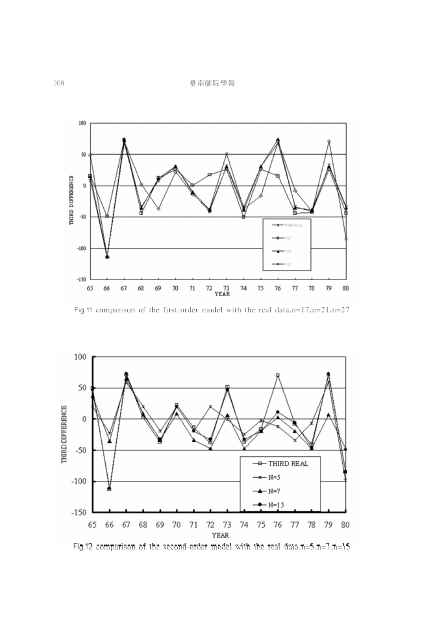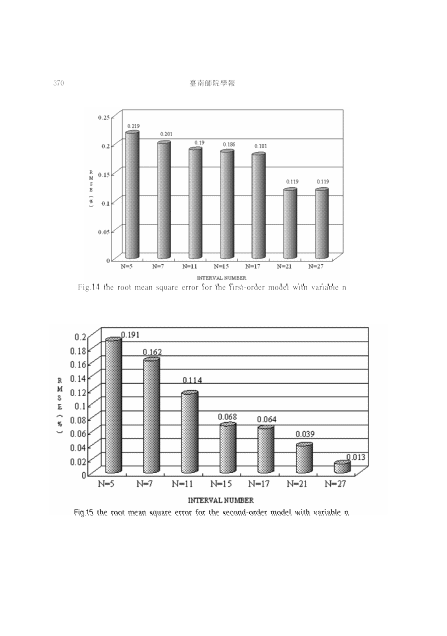
- •Study for High-Order Models of Fuzzy Time Series Chao-Chih Tsai
- •Abstract
- •Introduction
- •Review of fuzzy set theory and fuzzy time series
- •Fuzzy Set Theory
- •Fuzzy Time Series
- •Theory for model equation and forecasting procedures
- •Theory for model equation
- •Formulation of high-order models
- •119 LIij iy-
- •For all the historical knowledge, the two-step- ahead fuzzy relational functions are found and union operator is applied to obtained the two-step-ahead model:
- •(7*) Obtained the second possibility Ai2 for the forecasted output data using r22.
- •(8*) Take the intersection of Fj and f to form the output f(I).
- •Forecasting population
- •IlllIiij-
- •Idegree 2clegree 3degree 4degree 5clegree &leg ree 7degree degree of polynomial
- •Xj**flAflSm
IlllIiij-
Table.7 the yearly records and equivalent fuzzy set.
-
Year
Al
A2
A3
A4
A5
1973
0
0
0
1
0.1
1974
0
0
0
1
0.5
1975
0
0.1
0.1
0.9
0
1976
0
0
0
1
0.9
1977
1
0.5
0.5
0
0
1978
0
0
0
0.7
1
1979
0
0.1
0.1
0.9
0
1980
0
0.8
0.8
0.2
0
1981
0
0
0
1
0.3
1982
0
0.4
0.4
0.6
0
1983
0
0.9
0.9
0.1
0
1984
0
0
0
1
0.9
1985
0
0.8
0.8
0.2
0
1986
0
0.4
0.4
0.6
0
1987
0
0
0
0.7
1
1988
0
0.3
0.3
0.7
0
1989
0
0.9
0.9
0.1
0
1990
0
0
0
0.7
1
1991
0.8
1
1
0
0
6. Construct the fuzzy forecasting model.
Let R(1) be the first fuzzy relational function, which can be written as
R(1)=F(1)T X F(2) (24)
The elements of R(1) is defined as
r1=min(F(1)1, F(2)) (25)
Where Y(1)1 represents for the i-th element of Y(1), and for the j-th elements of Y(2). For all the historical knowledge, the fuzzy relational functions are found and union operator is applied to obtained the model:
R=Union of R(i) (26)
4 kl41 rIrt I
[P IJ1i
YTI
2. IL
14 t
I J 1 1t
-
‘
In the case of n=5, R is a matrix of 5 X 5 whose values are as follows:
-
o
o
0
0.7
1
o
0.4
0.8
0.9
0.9
R=
0.1
0.9
1
1
1
1
0.8
1
1
0.9
0.9
1
1
0.9
0.1
7. Obtained forecasted output data using R.
As the relational function is determined, historical data can be used to obtained the predicted values by
F(t)=F(t-1) R (27)
And the forecasted fuzzy sets in the case for n=5 are given in Table 8
Table.8 the forecasted fuzzy sets
Year |
Membership |
Normalized membership |
||||||||
1974 |
1 |
0.9 |
1 |
1 |
0.9 |
0.21 |
0.19 |
0.21 |
0.21 |
0.19 |
1975 |
1 |
0.8 |
1 |
1 |
0.9 |
0.21 |
0.17 |
0.21 |
0.21 |
0.19 |
1976 |
0.9 |
0.9 |
1 |
1 |
1 |
0.19 |
0.19 |
0.21 |
0.21 |
0.21 |
1977 |
1 |
0.9 |
1 |
1 |
0.9 |
0.21 |
0.19 |
0.21 |
0.21 |
0.19 |
1978 |
0 |
0.4 |
0.5 |
0.7 |
1 |
0 |
0.15 |
0.19 |
0.27 |
0.38 |
1979 |
00.9 |
1 |
1 |
0.9 |
0.7 |
0.2 |
0.22 |
0.22 |
0.2 |
0.16 |
1980 |
0.9 |
0.9 |
1 |
1 |
1 |
0.19 |
0.19 |
0.21 |
0.21 |
0.7 |
1981 |
0.2 |
0.9 |
1 |
1 |
1 |
0.05 |
0.22 |
0.24 |
0.24 |
1 |
1982 |
1 |
0.8 |
1 |
1 |
0.9 |
0.21 |
0.17 |
0.21 |
0.21 |
1 |
1983 |
0.6 |
0.9 |
1 |
1 |
1 |
0.13 |
0.2 |
0.22 |
0.22 |
0.7 |
1984 |
0.1 |
0.9 |
1 |
1 |
1 |
0.025 |
2.02 |
0.25 |
0.25 |
0.25 |
1985 |
1 |
0.9 |
1 |
1 |
0.9 |
0.21 |
0.19 |
0.21 |
0.21 |
0.19 |
1986 |
0.02 |
0.9 |
1 |
1 |
1 |
0.05 |
0.22 |
0.24 |
0.24 |
0.24 |
1987 |
0.6 |
0.9 |
1 |
1 |
1 |
0.013 |
0.2 |
0.22 |
0.22 |
0.22 |
1988 |
0.9 |
1 |
1 |
1 |
0.7 |
0.2 |
0.22 |
0.22 |
0.2 |
0.16 |
1989 |
0.7 |
0.9 |
1 |
0.9 |
1 |
0.15 |
0.2 |
0.22 |
0.22 |
0.22 |
1990 |
0.1 |
0.9 |
1 |
1 |
1 |
0.025 |
0.225 |
0.25 |
0.25 |
0.25 |
1991 |
0.9 |
1 |
1 |
1 |
0.7 |
0.2 |
0.22 |
0.22 |
0.2 |
0.16 |
1992 |
0.1 |
0.4 |
1 |
0.9 |
0.9 |
0.03 |
0.13 |
0.26 |
0.29 |
0.29 |
366
8. Transfer the output fuzzy set into forecasted records.
Since the output fuzzy results, they should be transfer into real numbers. The transferring process is called defuzzification [4,5]. The three-principle method [5
is used in this study.
100
10
50
-50
-100
 -150
-150
65 66 67 68 69 70 71 72 73 74 75 76 ‘77 78 79 80
YEAR
Fig.1O comparison of the first-order model with the real data,n=5,n=7,n=15
From the above calculations, it is found that the root mean square error is
0.119. Fig 10 shows the comparison of actual records and the current forecasted results.
For comparison, a second-order fuzzy time series model is developed for the same example. All the output fuzzy sets shown in Table 8 are useful, and they only serve as one of the possibility F1 of the final output fLizzy sets for the
second-order model. Following the same processes, the second possibility of the
final output fuzzy sets F12 are calculated as follows (Note that step 1- 4 are the same as the first-order model):
(5*) Setup the two-step-ahead fuzzy relations based on historical knowledge.
The first record in Table7 represents for the population in Taiwan area at 1973, and the maximum membership is under A4. Thus, we can view the first record as the linguistic A4. When all the historical data are transferred into linguistic
expressions, the logical relations can be constructed. Note that a two-step-ahead
projection is applied instead of one-step-ahead projection used in step 5 of the first-order model.
(6*) Construct the two-step-ahead fuzzy forecasting model R22.
Let R(1) be the first fuzzy relational function, which can be written as
367
R22 (1)=F(1)T X F(3)
R22 (2)=F(2)T X F(4) (28)
For example, the elements nj of R22 (1) is defined as
r=min(F(1), F(3)) (29)
For all the historical knowledge, the two-step-ahead fLizzy relational functions are found and union operator is applied to obtained the two-step-ahead model:
R 2 2=Union of R2(t) (30)
(7*) Obtained the second possibility Ai2 using R22.
As the two-step-ahead relational function is determined, historical data can be used To obtained the predicted values by
F17=F(i-2) R22 (31)
(8*) Take the intersection of F11 and F12 to form the output F(i).
Based on the proposed method, the essence of high-order time series models can be obtained while the simplicity of first-order calculation is retained. Furthermore, the formulation can be easily extended to higher-order models without any computational problems. The next section presents the application and comparisons of the results for the regression method, those for the first- and second-order models.

369
100
\
-100 1
 -150
-150
—S--THIRD REAL
—‘— 14=21
—*---N=27
65 66 67 68
Fig.13 comparison of the
69 70 71 72 73 74 75 76 77 78 79 80
 YEAR
YEAR
second-order model with the real data,n= 19,n=2 1,n=27
To reassure the effect of high-order model, the same example of the historical records of population in Taiwan area are analyzed using three different models (the regression method, the first and second-order models) with different numbers of fuzzy sets (n=5,7,15,19,21, and 27, where n represents for the number of fuzzy sets ). In Figs. 11-13, the results obtained from the first-order and the second-order models are compared with the actual data for n=5, 21, and 27, respectively. From these figures, the advantages of the proposed approach are clear. Better forecasting results are presented and the errors decrease for high values of n. This could be evidenced from Fig.14,l5, which shows the root mean square error obtained from forecasting models. The RMSE reduces from 0.17 for the regression method using the polynomial of degree
3 as shown in Fig.16, to 0.119 for the first-order model and 0.013 for the second-order model using n=27. This shows great improvement in forecasting results. The feasibility of the current formulation of the high-order fuzzy time series model is confirmed.

p 4 t I J 1iI J 1
[
rIrt I4 —I-’ TT1‘- Iu
1.6
R
M
S
E 0.8
0.6
04
0.2
0.17 022 0.22
0.32
